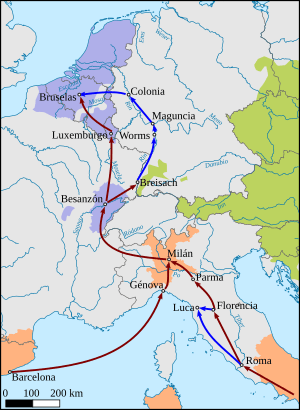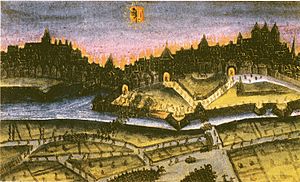Spanish Road facts for kids
The Spanish Road (called Camino Español in Spanish) was a very important military path and trade route. It was used in the late 1500s and early 1600s. This road connected different parts of the Spanish Empire that were ruled by the Habsburg family. These areas included the Duchy of Milan in Italy, the Franche-Comté (now part of France), and the Spanish Netherlands (now Belgium and the Netherlands).
This road was also known by other names, like the "Road of the Spaniards" or the "Road of the Spanish Tercios" (Spanish soldier groups).
King Philip II of Spain created the Spanish Road. It was a vital path for Spain during the Eighty Years' War against the Dutch Republic. Sending soldiers and supplies by sea from Spain to the Low Countries would have been faster. A ship could travel about 200 kilometers (124 miles) a day. Soldiers on the Spanish Road, however, walked only about 23 kilometers (14 miles) a day.
But Spanish ships sailing through the English Channel faced many attacks. The French, English, and Dutch were often enemies of Spain. So, it was much safer for Spain to send its armies across the Western Mediterranean Sea to Italy. From there, soldiers marched overland about 1,000 kilometers (621 miles) along the Spanish Road. This path went from Milan to Luxembourg, all through Spanish lands.
Between 1567 and 1633, about 123,000 soldiers traveled to the Spanish Netherlands using this land route. Only about 17,600 went by sea. The road eventually became unusable for Spain's military. This happened after France joined the Thirty Years' War on the Dutch side. France then took over Spanish lands along the route.
Contents
Why the Road Was Needed
The fight between King Philip II of Spain and the Dutch rebels in the Spanish Netherlands led to the Eighty Years' War. This conflict was part of a bigger struggle in Europe during the 1500s. It involved Catholics and Protestants.
By 1550, Spain had spent a lot of money on wars against German Protestants and France. This meant Spain had to create new taxes in the Spanish Netherlands. People were unhappy about these taxes. A bad harvest in 1565 also caused a famine in 1566. This year was known as the 'Year of Hunger'.
In 1566, there was a lot of social, political, and religious unrest. This led to protests and the destruction of religious images. It seemed to threaten the government in Brussels. Spanish troops, led by the Duke of Alba, were sent to restore order. They were also meant to punish those who rebelled. This started the Dutch Revolt and the Eighty Years' War.
Since troops could not be sent by sea, King Philip had to find a way to move them by land. He needed to get soldiers from his bases in Lombardy to the Spanish Netherlands. The Spanish Road was planned and mapped in 1566. The Duke of Alba used it for the first time in July 1567.
History of the Road
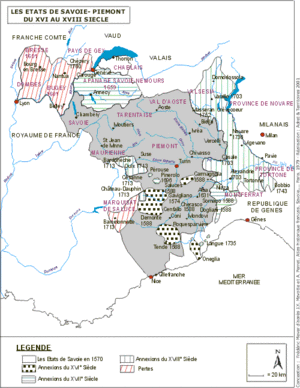
Early Route: Through Savoy
The first path of the Spanish Road went northwest from the Duchy of Milan. It passed through the Duchy of Savoy, which was an ally of Spain. From there, it went north through the Franche-Comté (Spanish land) and then the Duchy of Lorraine, another Spanish ally. Finally, it reached Luxembourg in the Spanish Netherlands.
The Duke of Alba's army used this route in 1567. Spanish forces continued to use it for the next 30 years without many problems.
However, around 1600, Savoy was defeated by France in a war. Under the Treaty of Lyon (1601), Savoy had to give two northern areas, Bugey and Bresse, to France. This meant a big part of the Spanish Road was now on French land. France was usually an enemy of Spain. So, Spanish troop movements along the road were blocked.
With the old route closed, Spain tried a new plan. They supported Charles Emmanuel I, Duke of Savoy in his attempt to conquer the Republic of Geneva. Geneva was next to both Savoy and Franche-Comté. If Savoy took Geneva, Spanish troops could bypass France. They could then reach Franche-Comté directly from Savoy. But Charles-Emmanuel's attack on Geneva failed. This event is still celebrated in Geneva today as the l'Escalade festival.
New Paths: Swiss and Valtellinese Routes
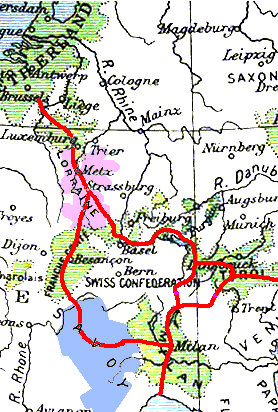
The failure to take Geneva meant the old route through Savoy could not be used. So, Spain looked for a new path to the east.
One option was to march north from Milan over the St Gotthard Pass. Then, they would go through Central Switzerland to the High Rhine river. Crossing the Rhine would bring them into Further Austria. This was friendly land because the Austrian Habsburgs were relatives and allies of Spain's royal family. From Further Austria, Spanish armies could go through Upper Alsace (another Austrian Habsburg land) to Lorraine and then to the Spanish Netherlands.
The Swiss Confederacy was willing to let Spanish troops pass. But the presence of Catholic soldiers, on their way to fight Protestants, worried the Protestant cantons. This could start new religious conflicts in Switzerland. To make the Spanish troops less noticeable, the Swiss set rules. For example, a 1604 treaty said Spanish soldiers had to march unarmed. They could only be in groups of 200 men at a time. These rules made it hard for Spain to move troops quickly. Spain only sent six major groups this way before giving up on it.
Another option was to go even further east. Spanish armies could march northeast from Milan through the Valtellina. This was the southernmost area of the Three Leagues. At the end of the Valtellina was the Stelvio Pass. On the other side was the County of Tyrol, another Austrian Habsburg land. From there, Spanish forces could go northwest through Further Austria to Upper Alsace, then north through Lorraine to the Spanish Netherlands. The Spanish Governor of Milan had already made a deal with the Three Leagues to use this route in 1592.
However, the Three Leagues, like Switzerland, had both Catholic and Protestant areas. The Protestants there did not like the Spanish presence, just like their Swiss neighbors. Also, Spain's enemies, France and Venice, encouraged this dislike. In 1603, Venice convinced the Leagues to give them special access to the Valtellina. This canceled the agreement with Spain. The Spanish governor built Fort Fuentes on the border to scare the Three Leagues into changing their minds. But it did not work much.
By 1610, all three paths of the Spanish Road were mostly blocked for Spanish troops. This was due to France taking Bugey and Bresse, strict rules in Switzerland, and the Venetian deal with the Three Leagues. But this was not a big problem for a while. In 1609, the Twelve Years' Truce began. This stopped the fighting in the Eighty Years' War and meant Spain did not need to send many soldiers.
The Valtellina Route Reopens
The Twelve Years' Truce ended early in 1619. Spain then had to start sending large armies to the Low Countries again. So, it was very important to reopen the Spanish Road quickly.
The new Governor of Milan started a Catholic uprising in the Three Leagues. This caused a religious civil war there. While the Leagues fought, he invaded the Valtellina. He wanted to take the area completely and reopen the Spanish Road through Tyrol. This worried France, which sent an army to the Valtellina. The resulting Valtellina War ended in a tie. Under the Treaty of Monzón (1626), Spain had to give the Valtellina back to the Three Leagues. But, importantly, the road through Valtellina to the Stelvio Pass was reopened. This allowed soldiers to use the Spanish Road again.
Many Spanish armies traveled along the reopened Spanish Road in the late 1620s and early 1630s. Some went to the Low Countries, and others went to Germany. The Thirty Years' War was happening there, and Spain supported the Austrian Habsburgs. One Spanish army that used the road was led by Cardinal-Infante Ferdinand. This army won important battles in Germany, including the First Battle of Nördlingen.
The End of the Road
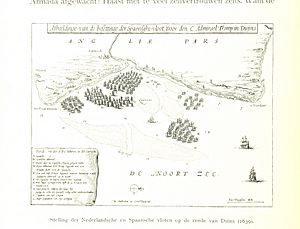
The Habsburg victories in Germany worried the French leader, Cardinal Richelieu. In 1635, France joined the Thirty Years' War against Austria. France also declared war on Spain. In the late 1630s, a French general led a second French attack into the Valtellina. This made it hard for Spanish troops to move through the valley. Other French forces invaded Upper Alsace. They conquered it and kept it after defeating the Austrians.
This meant the Spanish Road was cut in two places. It was blocked in the south between Milan and Tyrol. It was also blocked in the north between Further Austria and Lorraine.
With the Spanish Road closed, Spain had to send its armies to the Low Countries by sea again. In 1639, a Dutch admiral attacked one of these convoys off the English coast. This was the Battle of the Downs. The Dutch destroyed the Spanish fleet that was protecting the troop ships. This huge defeat badly hurt Spain's navy. It made it almost impossible for Spain to send soldiers and supplies to its army. This major problem helped bring an end to the Eighty Years' War.
Life on the Road
There were no organized places for soldiers to stay along the Spanish Road. Officers sometimes stayed in towns. But their men had to sleep under trees or build simple shelters. Local people were often scared of the soldiers. Armies back then were known for stealing and damaging things, even in friendly areas. In 1580, Spanish officers took over a house. They found no furniture inside because the owners had removed it all. They did not want it to be broken or stolen.
Armies only marched along the Spanish Road once or twice a year. So, there were no regular military supply stores. However, there was a system to get food for troops at certain points. Officials from the Spanish Netherlands or Milan would arrange prices and supplies.
In Savoy, there were permanent stops where soldiers and merchants could get food and shelter. In Franche-Comté, Lorraine, and the Spanish Netherlands, supplies were arranged as needed. Private companies would calculate the food and payments based on how many soldiers were coming and when.
Impact of the Road
At first, the Spanish Road was only for military use. But it also became an important trade route. It connected the Mediterranean Sea to Northern Europe, much like older trade paths. The road also made Spain improve its diplomatic ties in the Alpine region. This led to Spain setting up permanent embassies in Savoy and Switzerland. These embassies were managed from Milan.
One unexpected result of the Spanish Road was the spread of the plague. Soldiers and merchants traveling along it carried the disease. This happened especially in Valtellina after the Valtellina War.
|
See also
 In Spanish: Camino Español para niños
In Spanish: Camino Español para niños
- Oñate treaty
- Treaty of Lyon (1601)
- Treaty of Monzón
- Valtellina War
- Eighty Years' War
- Thirty Years' War
- Middle Francia
- History of Burgundy
- Kingdom of Burgundy
- Burgundian Circle
- Blue Banana


